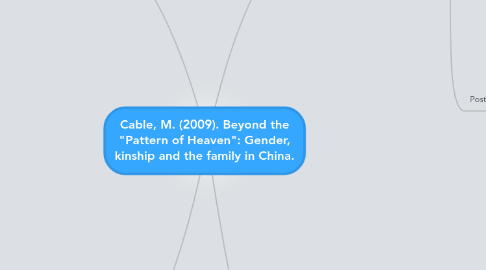
1. The Lahu Chinese
1.1. Noted for gender equality, great value is placed on gender unity
1.2. No preference for male children
1.3. Kinship is bilateral and the household is run jointly with both parents actively participating in the children's lives.
1.4. The married couple is viewed as more important than the individuals in the marriage.
1.5. Unlike the Han, Lahu men partake in pregnancy, childbirth, and child care.
2. The Mosuo Chinese
2.1. Matrilineal group
2.2. "Walking marriage"- men visit women at night in the woman's natal home they have intercourse and the man leaves in the morning. A man may visit multiple women in one night and a woman may have multiple visitors a night.
2.3. Marriage does exist but is not required and the Mosuo do not have any word for for in-laws, husband, or father.
2.4. Children typically do not know who their father is and the male figure in their life is usually an uncle.
3. The Han Chinese
3.1. Confucianism is primary in private and social life
3.2. Filial piety is stressed as necessary to become a junzi.
3.3. Patrilineal kinship, the woman is only mentioned as a wife, mother, or sister in records,
3.4. Surnames were a way to tell which family a person was from and the person's lineage
3.5. Life stage of the women
3.5.1. Girls had a higher rate of infanticide since they were viewed as a guaranteed loss
3.5.2. Most important life event: Marriage
3.5.2.1. Girls could also be bought and raised in a household for the purpose of marrying the son of the purchasing household.
3.5.3. Divorce- women could not initiate a divorce
3.6. Nuance in Kinship
3.6.1. Uterine families- those relationships between a mother and her child or children
3.6.1.1. Cause of loyalty to mother and protection of her interests as she aged possibly to the cost of patriline.
3.6.2. Yang cycle- a complex system of mutual responsibility between parents and children
3.6.2.1. Parents provide for children when they are you and when the parents are old the children provide for the parents.
3.7. Post 1949
3.7.1. Migration policy bound son's to their natal home
3.7.2. Marriage Law
3.7.2.1. Outlawed concubinage and marriage betrothal
3.7.2.2. Gave women the right to initiate divorce
3.7.3. Pressure to abandon ancestors worship and other "superstitious" practices caused many family shrines and temples to disappear
3.7.4. One child policy
3.7.4.1. Has caused in imbalance in the male to female ration due to sons being preferred over daughters.
3.7.4.2. Infanticide and abortions
3.7.4.3. Modifications to the law
3.7.4.3.1. Second child if the first died from a non-genetic related illness
3.7.4.3.2. Both parents are only children
